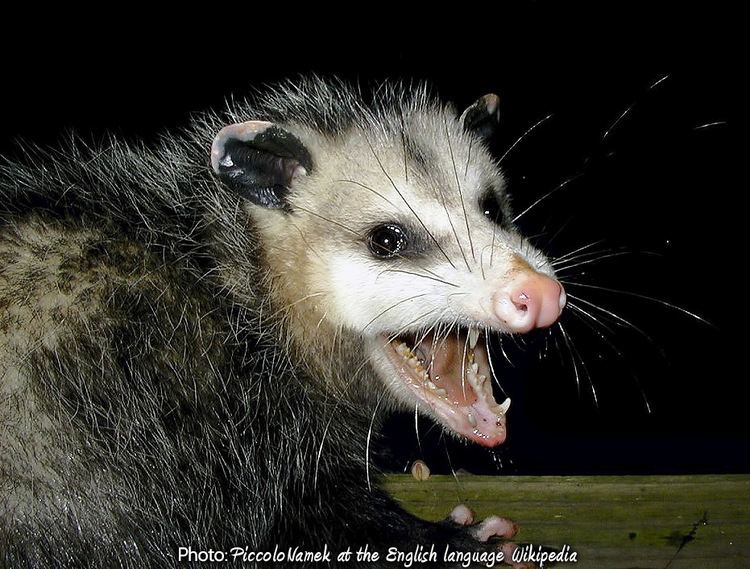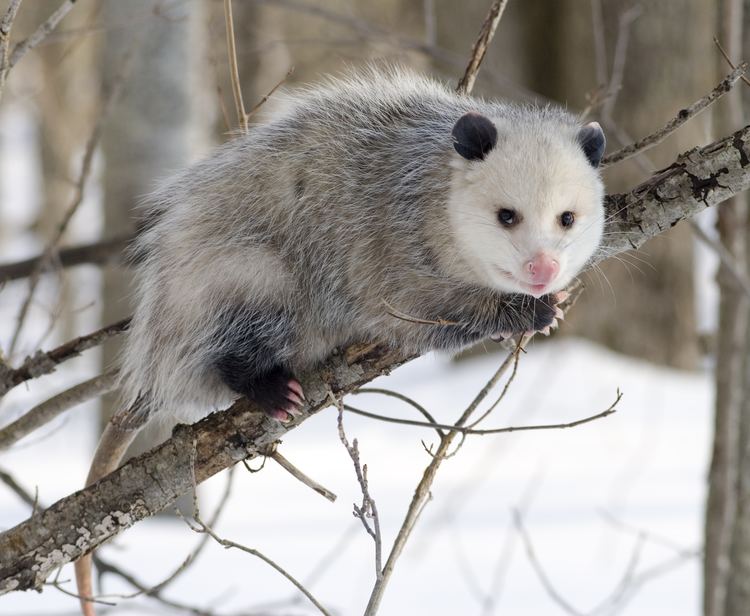Scientific name Didelphimorphia | Family DidelphidaeGray, 1821 | |
Tail length Virginia opossum: 22 – 47 cm, Common opossum: 61 cm Lower classifications | ||
Is this opossum dead
The opossums, also known as possums, are marsupial mammals of the order Didelphimorphia /daɪˌdɛlfᵻˈmɔːrfiə/). The largest order of marsupials in the Western Hemisphere, it comprises 103 or more species in 19 genera. Opossums originated in South America, and entered North America in the Great American Interchange following the connection of the two continents. Their unspecialized biology, flexible diet, and reproductive habits make them successful colonizers and survivors in diverse locations and conditions.
Contents
- Is this opossum dead
- Cute opossum scent marking loving possum rehabilitation
- Etymology
- Characteristics
- Reproduction and life cycle
- Behavior
- Biochemistry
- Habitat
- Hunting and foodways
- Classification
- References

Cute opossum scent marking loving possum rehabilitation
Etymology

The word "opossum" is borrowed from the Virginia Algonquian (Powhatan) language and was first recorded between 1607 and 1611 by John Smith (as opassom) and William Strachey (as aposoum). Both men encountered the language at the British settlement of Jamestown, Virginia, which Smith helped to found and Strachey later served as its first secretary. Strachey's notes describe the opossum as a "beast in bigness of a pig and in taste alike," while Smith recorded it "hath an head like a swine ... tail like a rat ... of the bigness of a cat." The Powhatan word ultimately derives from a Proto-Algonquian word (*wa·p-aʔθemw-) meaning "white dog or dog-like beast."

The opossum is also commonly known as a possum, particularly in the Southern United States and Midwest. Following the arrival of Europeans in Australia, the term "possum" was borrowed to describe distantly related Australian marsupials of the suborder Phalangeriformes, which are more closely related to other Australian marsupials such as kangaroos.
"Didelphimorphia" refers to the fact that, like all marsupials, these animals have two("di") wombs("delphus").
Characteristics

Didelphimorphs are small to medium-sized marsupials, ranging in size from a small mouse to a large house cat. They tend to be semi-arboreal omnivores, although there are many exceptions. Most members of this taxon have long snouts, a narrow braincase, and a prominent sagittal crest. The dental formula is: 5.1.3.44.1.3.4. By mammalian standards, this is an unusually full jaw. The incisors are very small, the canines large, and the molars are tricuspid.
Didelphimorphs have a plantigrade stance (feet flat on the ground) and the hind feet have an opposable digit with no claw. Like some New World monkeys, opossums have prehensile tails. Like all marsupials, the fur consists of awn hair only, and the females have a pouch. The tail and parts of the feet bear scutes. The stomach is simple, with a small cecum. Notably, the male opossum has a forked penis bearing twin glandes.
Opossums have a remarkably robust immune system, and show partial or total immunity to the venom of rattlesnakes, cottonmouths, and other pit vipers. Opossums are about eight times less likely to carry rabies than wild dogs, and about one in eight hundred opossums is infected with this virus.
Although all living opossums are essentially opportunistic omnivores, different species vary in the amount of meat and vegetation they include in their diet. Members of the Caluromyinae are essentially frugivorous; whereas the lutrine opossum and Patagonian opossum primarily feed on other animals. The yapok (Chironectes minimus) is particularly unusual, as it is the only living semi-aquatic marsupial, using its webbed hindlimbs to dive in search of freshwater mollusks and crayfish. Most opossums are scansorial, well-adapted to life in the trees or on the ground, but members of the Caluromyinae and Glironiinae are primarily arboreal, whereas species of Metachirus, Monodelphis, and to a lesser degree Didelphis show adaptations for life on the ground.
Reproduction and life cycle
As a marsupial, the female opossum has a reproductive system that includes a bifurcated vagina, a divided uterus and a marsupium, which is her pouch. The average estrous cycle of the opossum is about 28 days. Opossums do possess a placenta, but it is short-lived, simple in structure, and, unlike that of placental mammals, is not fully functional. The young are therefore born at a very early stage, although the gestation period is similar to many other small marsupials, at only 12 to 14 days. Once born, the offspring must find their way into the marsupium to hold on to and nurse from a teat.
Female opossums often give birth to very large numbers of young, most of which fail to attach to a teat, although as many as thirteen young can attach, and therefore survive, depending on species. The young are weaned between 70 and 125 days, when they detach from the teat and leave the pouch. The opossum lifespan is unusually short for a mammal of its size, usually only two to four years. Senescence is rapid.
The species are moderately sexually dimorphic with males usually being slightly larger, much heavier, and having larger canines than females. The largest difference between the opossum and non-marsupial mammals is the bifurcated penis of the male and bifurcated vagina of the female (the source of the term "didelphimorph," from the Greek "didelphys," meaning double-wombed). Opossum spermatozoa exhibit sperm-pairing, forming conjugate pairs in the epididymis. This may ensure that flagella movement can be accurately coordinated for maximal motility. Conjugate pairs dissociate into separate spermatozoa before fertilization.
Behavior
Opossums are usually solitary and nomadic, staying in one area as long as food and water are easily available. Some families will group together in ready-made burrows or even under houses. Though they will temporarily occupy abandoned burrows, they do not dig or put much effort into building their own. As nocturnal animals, they favor dark, secure areas. These areas may be below ground or above.
When threatened or harmed, they will "play possum", mimicking the appearance and smell of a sick or dead animal. This physiological response is involuntary (like fainting), rather than a conscious act. In the case of baby opossums, however, the brain does not always react this way at the appropriate moment, and therefore they often fail to "play dead" when threatened. When an opossum is "playing possum", the animal's lips are drawn back, the teeth are bared, saliva foams around the mouth, the eyes close or half-close, and a foul-smelling fluid is secreted from the anal glands. The stiff, curled form can be prodded, turned over, and even carried away without reaction. The animal will typically regain consciousness after a period of a few minutes to 4 hours, a process that begins with slight twitching of the ears.
Adult opossums do not hang from trees by their tails, as sometimes depicted, though babies may dangle temporarily. Their semi-prehensile tails are not strong enough to support a mature adult's weight. Instead, the opossum uses its tail as a brace and a fifth limb when climbing. The tail is occasionally used as a grip to carry bunches of leaves or bedding materials to the nest. A mother will sometimes carry her young upon her back, where they will cling tightly even when she is climbing or running.
Threatened opossums (especially males) will growl deeply, raising their pitch as the threat becomes more urgent. Males make a clicking "smack" noise out of the side of their mouths as they wander in search of a mate, and females will sometimes repeat the sound in return. When separated or distressed, baby opossums will make a sneezing noise to signal their mother. If threatened, the baby will open its mouth and quietly hiss until the threat is gone.
Biochemistry
Opossums are remarkably resistant to snake venom, ricin, and botulinum toxin.
Habitat
Opossums are found in the Americas.
Hunting and foodways
The Virginia opossum was once widely hunted and consumed in the United States. Sweet potatoes were eaten together with the possum in America's southern area. South Carolina cuisine includes opossum eating. Jimmy Carter killed opossums in addition to other small game. Raccoon, opossum, partridges, prairie hen, and frogs were among the fare Mark Twain recorded as part of American cuisine.
Opossum farms have been operated in the United States.
In Dominica, Grenada, Trinidad and St. Lucia the common opossum or manicou is popular and can only be hunted during certain times of the year owing to overhunting. The meat is traditionally prepared by smoking, then stewing. It is light and fine-grained, but the musk glands must be removed as part of preparation. The meat can be used in place of rabbit and chicken in recipes. Historically, hunters in the Caribbean would place a barrel with fresh or rotten fruit to attract opossums that would feed on the fruit or insects.
In northern/central Mexico, opossums are known as "tlacuache" or "tlacuatzin". Their tails are eaten as a folk remedy to improve fertility. In the Yucatán peninsula they are known in the Yucatec Mayan language as "och" and they are not considered part of the regular diet by Mayan people, but still considered edible in times of famine.
Opossum oil (possum grease) is high in essential fatty acids and has been used as a chest rub and a carrier for arthritis remedies given as topical salves.
Opossum pelts have long been part of the fur trade.
Classification
Classification based on Voss and Jansa (2009)
